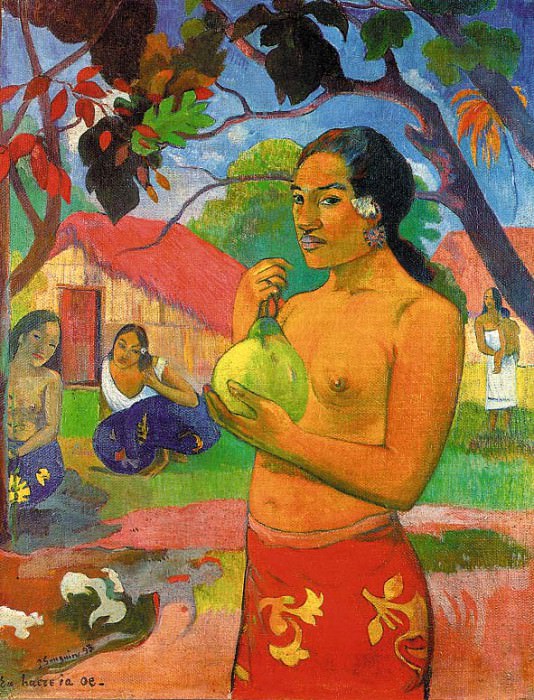15314 Paul Gauguin (1848-1903)
Paul Gauguin – 15314
Edit attribution
Download full size: 591×775 px (0,1 Mb)
Painter: Paul Gauguin
Gauguin painted this painting while on the island of Tahiti. In the background are two ordinary huts located in a settlement of islanders. In the foreground stands a young woman, a Tahitian woman, holding a fruit. This fruit is a mango, distinguished by its lemon-greenish color. Many critics note that the fruit itself resembles a vessel, and some researchers of the artist’s work are sure that this is the very real vessel for water, carved in a gourd.
Description of Paul Gauguin’s painting "Woman Holding a Fetus (1893)"
Gauguin painted this painting while on the island of Tahiti. In the background are two ordinary huts located in a settlement of islanders. In the foreground stands a young woman, a Tahitian woman, holding a fruit. This fruit is a mango, distinguished by its lemon-greenish color. Many critics note that the fruit itself resembles a vessel, and some researchers of the artist’s work are sure that this is the very real vessel for water, carved in a gourd. Thus, the woman may be about to go for water, holding the vessel by the rope placed on top of the fruit.
According to a certain version, the heroine of the painting is a young Tahitian woman Tehura, who was the wife of Gauguin, but between them there was no ceremony of marriage. Her face has expressive features, her look is serious and concentrated. She has dark skin, painted in gold and brown colors, which stands out against the general background of the painting. Her body silhouette is described with a clear line that makes her seem three-dimensional and expressive. The landscape behind the woman looks rather flat and generalized.
The artist has depicted neither the rays of the sun, nor the movement of the air. On the contrary, the entire painting is saturated with tropical heat, which filled the huts, grass and trees, as well as frozen on the skin of the islander dressed in a skirt in deep red. The pattern depicted on her clothing merges with the patterns of the leaves on the trees. This gives her a kind of mystery, making her an integral part of the surrounding nature. The painting is particularly poetic, full of vivid colors and exotic motifs. You can feel the strong connection between people and nature, seemingly eternal and unbreakable. According to rumors, the woman was pregnant by Gauguin, which is hinted at by the fetus she is holding in her hands.
Кому понравилось
Пожалуйста, подождите
На эту операцию может потребоваться несколько секунд.
Информация появится в новом окне,
если открытие новых окон не запрещено в настройках вашего браузера.
You need to login
Для работы с коллекциями – пожалуйста, войдите в аккаунт (open in new window).




















You cannot comment Why?
In the background, several other figures are present. To the left, two women are seated. One is partially visible, wearing a blue sarong. The other, in the mid-ground, is also seated, dressed in a darker blue skirt and white top, with her hand raised near her face, possibly in thought or conversation. Further in the background, on the right, another woman stands holding a child.
The environment is lush and vibrant, with a bright blue sky dotted with clouds. Trees with dark, textured branches and richly colored leaves in shades of green, red, and orange frame the scene from above. Traditional thatched-roof huts with red facades are visible behind the figures, suggesting a village setting. The ground is a carpet of greens, reds, and yellows, with abstract, stylized white and grey forms in the lower left quadrant that could represent birds or other symbolic elements.
The subtexts of the painting explore themes of exoticism, natural beauty, and the perceived innocence of indigenous cultures for European artists of the time. The direct gaze of the central figure, coupled with her minimal attire and the fertile landscape, can be interpreted as a representation of natural sensuality and a connection to a primal, uncorrupted existence. The presence of the fruit, often a symbol of knowledge or temptation, adds another layer of potential meaning. Gauguins work from this period often aimed to capture a spiritual or mystical essence of the places he visited, contrasting them with the perceived materialism and spiritual decline of Western civilization. The painting invites contemplation on the depiction of the other through a European lens, questioning notions of progress and cultural purity.